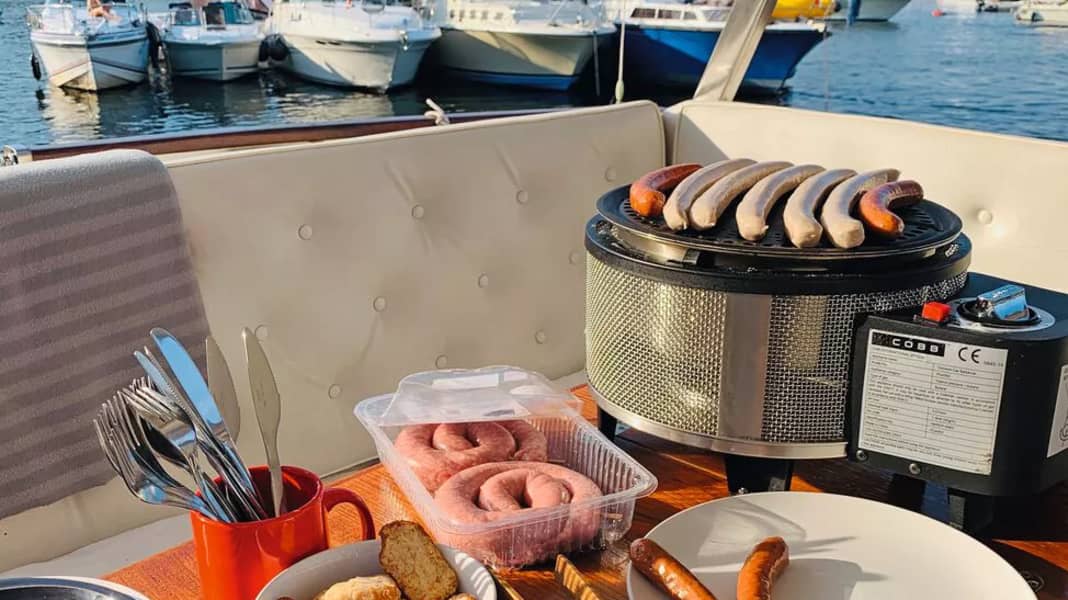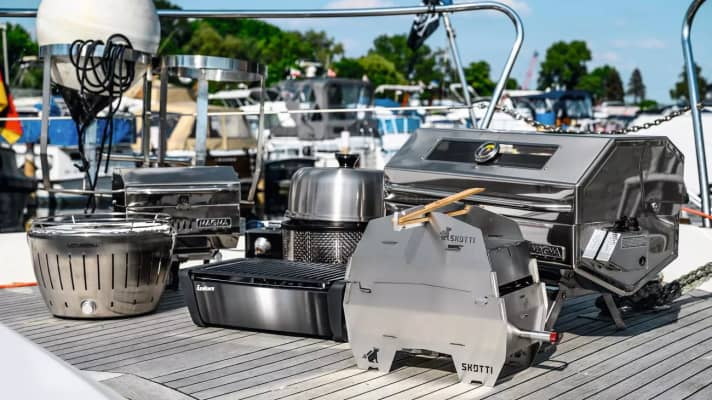
Coal or gas? The often endless discussions among hobby barbecuers often provide enough fuel for heated debates. If you now throw modern electric barbecues into the verbal boxing ring, there won't be a unanimous decision until the next century. But which system is better will probably remain a question of personal taste forever. Although the flavour of the meat is completely different with charcoal, the effort involved in using it is significantly higher compared to an electric or gas barbecue. However, when used on board, many other factors also play an important role that are rather secondary in normal everyday life. As on land, cooking time, feel and cleaning effort are aspects that everyone should test before buying a new barbecue. On board, packing size and temperature development are also crucial. We tested the three large systems on the boat and took a closer look at seven on-board barbecues. In terms of appearance and design, the competitors could hardly be more different. They are round, square, wide, narrow; small and compact, heavy and bulky.
On smaller boats, the first choice is probably the Skotti, which is powered by a gas cartridge and is the winner in terms of pack size. Thanks to the plug-in design of the individual elements, the barbecue can be stored compactly and flat without taking up much storage space. The stated assembly time of less than one minute definitely requires practice and presumably only refers to the barbecue itself and not to the plug-in lid, which can also be purchased as an option. The Skotti makes up for what at first glance appears to be a small grilling surface with plenty of power. Sausages and meat were ready to serve in no time at all. However, due to the heat development, we would advise against using it on board. As all components of the Skotti emit the high temperatures via the stainless steel frame, the feet may also leave burn marks or even holes in the GRP or gelcoat of the boats. In addition, grease runs out of the assembled elements, which can drip hot onto the boat and cause ugly stains. In our opinion, it is therefore unsuitable for "barbecuing on board". However, there is nothing to be said against using it on the beach or at the barbecue area.
Batteries and a USB cable for a barbecue? What may sound strange at first glance is a simple but well thought-out and helpful system. The charcoal barbecues in the test from Lotus and Enders both have an integrated fan that can be controlled by a regulator. The charcoal glows extremely quickly when the fan is running at full speed after lighting. In addition to the battery compartment, both barbecues have a USB port to which a power bank can be connected for even longer grilling times. The batteries were included with the Lotus, but were missing from the packaging of the Enders.
The Enders is ideal as a table grill on board. The recessed grips on the sides allow it to be repositioned at any time. The ambient light on the underside of the barbecue is a nice visual gimmick. Whether you really need it in the end, however, remains to be seen.
In practice, the Enders took the longest to get up to temperature, as the ignition gel had to be ignited several times before it finally burned. However, the Lotus was not much faster. However, the cast iron plate of the Enders was clearly preferable to the grate of the Lotus when comparing the charcoal barbecues. We also had the feeling that the Lotus grill could do with a slightly larger charcoal tray, as the heat could not spread over the entire grilling surface. Only when the fan was running at full speed was enough heat generated to cook meat. The optional lid could possibly help here.

In keeping with American barbecue culture, the large Monterey infrared from the US company Magma was the battleship of the test. With two grilling levels, a display window and a temperature display, the grill had a lot more to offer than its stainless steel counterparts. However, its price is like a good piece of meat: very high. At over 1,000 euros, the barbecue is probably not suitable for the leisure captain with an affinity for barbecuing. The design is also more suitable for larger boats and yachts with a few guests on board. Both Magma barbecues have a drip tray to catch the dripping fat. In our opinion, the valve to which the large 10 kg gas bottle is connected could be improved on the Monterey. We found the play on the cap to be a little too wobbly. The regulator on the Trailmate could also be improved. As the only barbecue in the test that is specially designed for use on boats, the Magma Trailmate, just like the extra-large Monterey, offers various brackets for railings and tables as well as a variety of other mounting options on deck in addition to the folding legs.
However, the Cobb grill was the best overall package for the test eaters. Not too big for use on board, with a lid for controlled heat development, easy to keep clean thanks to the cast-iron plate, can also be touched during use and, last but not least, is self-igniting. In addition, thanks to the optional accessories, the Cobb offers a variety of other uses, such as an oven.
After the barbecue is before the barbecue. Cleaning can often be very time-consuming if burnt-on residues are not removed immediately. Especially on small boats, the fresh water tanks or the sink often lack the capacity for this. In the test, the Cobb barbecue and the Enders were convincing in the cleaning category. One of the reasons for this is the cast iron plate, which sets them apart from other models with a grill grate. A drip tray can be filled with water at the bottom to prevent dripping fat from burning directly. The Magma grill is a little more complicated to clean. Due to the many corners and edges, cleaning is much more intensive and time-consuming than with the other grills. This applies to both the small and the large grill. With the Monterey, a second layer of fine grill grates must also be cleaned for the meticulous cleaner.
The last of the bunch, however, is the Skotti. Due to its enormous heat development and the lack of a drip tray, burnt spots appeared on some sheet metal parts that could not be removed with a normal sponge.
Conclusion: Even though the struggle between coal and gas barbecues will probably continue for a thousand years, we are fans of gas barbecues on board. Even with coconut charcoal briquettes, which are known for their almost non-existent flying sparks, the risk of burn marks is significantly higher than with a gas barbecue. A word about the Lono electric barbecue from WMF: It is just as easy to use as a gas barbecue. The grilling result is good, and the individually adjustable and removable plates increase the convenience of grilling and cleaning enormously. Disadvantage: There must always be a 230 V socket nearby. Our recommendation: Gas barbecues are ideal for use on board.
You can find the complete market overview of on-board barbecues with all the test results in BOOTE issue 08/2022 - from 13 July 2022 at newsagents or online directly in the Delius Klasing Shop.

